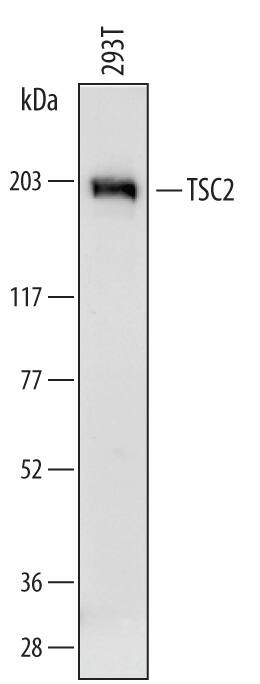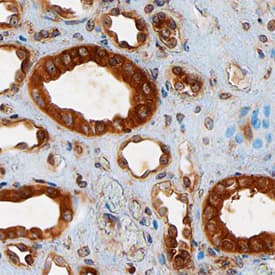Human TSC2 Antibody
R&D Systems, part of Bio-Techne | Catalog # AF4040


Key Product Details
Species Reactivity
Applications
Label
Antibody Source
Product Specifications
Immunogen
His1506-Lys1748
Accession # P49815
Specificity
Clonality
Host
Isotype
Scientific Data Images for Human TSC2 Antibody
Detection of Human TSC2 by Western Blot.
Western blot shows lysates of 293T human embryonic kidney cell line. PVDF membrane was probed with 0.5 µg/mL of Sheep Anti-Human TSC2 Antigen Affinity-purified Polyclonal Antibody (Catalog # AF4040) followed by HRP-conjugated Anti-Sheep IgG Secondary Antibody (Catalog # HAF016). A specific band was detected for TSC2 at approximately 200 kDa (as indicated). This experiment was conducted under reducing conditions and using Immunoblot Buffer Group 1.TSC2 in Human Kidney.
TSC2 was detected in immersion fixed paraffin-embedded sections of human kidney using Sheep Anti-Human TSC2 Antigen Affinity-purified Polyclonal Antibody (Catalog # AF4040) at 3 µg/mL overnight at 4 °C. Tissue was stained using the Anti-Sheep HRP-DAB Cell & Tissue Staining Kit (brown; Catalog # CTS019) and counterstained with hematoxylin (blue). Specific staining was localized to epithelial cells. View our protocol for Chromogenic IHC Staining of Paraffin-embedded Tissue Sections.Applications for Human TSC2 Antibody
Immunohistochemistry
Sample: Immersion fixed paraffin-embedded sections of human kidney
Western Blot
Sample: 293T human embryonic kidney cell line
Formulation, Preparation, and Storage
Purification
Reconstitution
Formulation
Shipping
Stability & Storage
- 12 months from date of receipt, -20 to -70 °C as supplied.
- 1 month, 2 to 8 °C under sterile conditions after reconstitution.
- 6 months, -20 to -70 °C under sterile conditions after reconstitution.
Background: TSC2
TSC-2 (Tuberous sclerosis complex protein 2; also tuberin) is a 190-220 kDa intracellular GTPase activating protein. It is widely expressed, and plays a central role in mTOR activation. In quiescent cells, TSC-2 is non-covalently bound to both membrane-embedded TSC-1 (a structurally unrelated protein) and polycystin-1. In this complex, TSC-2 represses mTOR activity by converting GTP-Rheb to GDP-Rheb. When AKT is activated (via growth factor signaling), TSC-2 is phosphorylated, binds to 14-3-3 protein, dissociates from its complex, and stops converting GTP-Rheb to GDP-Rheb. Human TSC-2 is 1807 amino acids (aa) in length. It contains two coiled-coil regions (aa 346-371 and 1008-1021), and one Rap-GAP domain (aa 1531-1758). Phosphorylation regulates TSC-2 activity and there are at least 19 utilized phosphorylation sites. Multiple splice variants exist. Singularly, or in combination, there are deletions of aa 1272-1294, 76-112, 946-988, and 946-989. Single point mutations abound, some of which impact phosphorylation. There is also a potential alternative start site 91 aa upstream of the standard site. Over aa 1506-1748, human TSC-2 shares 85% aa identity with mouse TSC-2.
Long Name
Alternate Names
Gene Symbol
UniProt
Additional TSC2 Products
Product Documents for Human TSC2 Antibody
Product Specific Notices for Human TSC2 Antibody
For research use only
